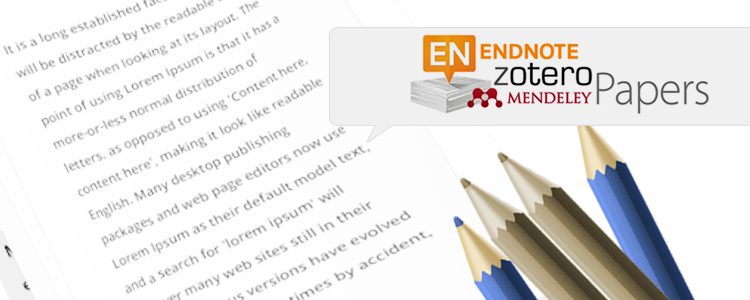Reference Managers: Tools to Stay on Top of Your Literature

A good literature review is the building ground for carrying out an efficient and well-designed research project. One of the main qualities of research work is to bring out a new piece of knowledge. Hence, it is important to be aware of what is already known when starting out a project. Before creating new data, researchers have to understand the existing data in their field, so that they can reach what they are pursuing in the best conditions possible, i.e., with the simplest route and the minimal cost. Also, one has to handle multiple references, from multiple journals, and publishers, along the realization of their research and organizing all this together in a homogeneous manner, can be very nerve-racking. Until the early 1990’s, researchers had to enter literature manually when inserting literature citations in their manuscripts. Depending on whether the journal was asking for references to be text-ordered (e.g. in Chemistry and Physics) or alphabetically ordered (in Life Sciences), modifying one’s reference list would be painful.
Origins of Reference Managers
Reference management (RM) softwares, or reference managers, first appeared in the late 1990’s. The first feature that was implemented was the correct formatting of article citations according to different journal reference styles. Even though fewer journals existed in the scientific world at that time, there were already multiple formats that authors were requested to use for articles they cited. So if a manuscript was rejected by the first journal and submitted elsewhere, or if the authors decided that their manuscript would be sent to another journal other than the one originally picked, then they could easily re-format the literature and concentrate more on the text and figures of their manuscript.
Nowadays, it is standard for most reference managers to include the citation style of the journal you want to submit to, allowing you to easily pick it from a menu or a drop-down list. Most softwares also have shortcuts to the main online literature databases, from which citations, abstracts, or full articles can be directly downloaded.
Existing Software and its Desirable Features
Here is a list of RM softwares with the broadest use among the scientific community. All but the first one have a free version which covers most of their features.
- EndNote™ was historically the first RM software. It continues to be regularly developed, however, no free version is proposed.
- Mendeley was launched in London in 2008. It introduced more stress on the article or pdf file rather than on the citation only. It is free until 2GB of storage (as of January 2017).
- Readcube was co-created by a researcher and a computer scientist. It has a strong web interface and accepts citations from all other main reference managers.
- Zotero is maintained by the Roy Rosenzweig Center for History and New Media. It is designed for the collection of different materials such as scientific and regular media articles, as well as audio files and images.
- Citavi is a Germany-based software. It has a database-like functioning, thus is able to accept and handle references of multiple types.
Classifying References
One main goal of reference managers is to classify literature references. Some researchers use different folders and a standardized naming scheme for their literature files (e.g., per author, year or main topic), which is now done by reference managers. This enables a more flexible and searchable classification, hence making the daily life of a researcher easier. One does not have to search across the many heaps on their desk in order to find that precise reaction protocol as this search can now be done on their computer. For such searches to be optimized, one still has to think beforehand on what classification is best for them. In some topics, it might be that a chronological classification is best, while in others, classifying according to sub-labels or personal labels, such as organisms or reagents, might be more relevant. All these possibilities are proposed by most RM softwares and are definitely worth being explored and used.
Additional Features
Some of the mentioned reference managers propose extra features which may be relevant or just implemented to differentiate from the competition.
Most of them propose a Web-based version. This is convenient if you need to connect to your literature from multiple places, e.g. when attending conferences or visiting other institutions. But some features may be missing with respect to the Desktop equivalent.
- Mendeley now implements more online features, extending from RM to web-social functionalities: “connecting” to other scientists, storing and sharing your datasets, searching for jobs. The desktop version tends to do online searches regularly, which can slow down the program.
- Readcube searches databases and makes new literature suggestions on a regular basis based on your existing literature.
- Zotero is designed for handling multiple file types. It may be relevant if you e.g. rely on podcasts on a regular basis. It also enables tags on library items, a convenient feature when items correspond to multiple topics.
Preferred Reference Managers
Even though the number of reference management softwares have been increasing over the last four or five years, only a few of them are dominantly used. According to the versions, some may work better with a given OS, so you should double-check their compatibility before installing. When using a reference manager, one does not necessarily need multiple features. Hence, if you already use one, you should stick to it. However, if not, and unless you are looking for specific features, try two or three of the main softwares that people around you use, and pick the one which you feel is more comfortable for your usage.










